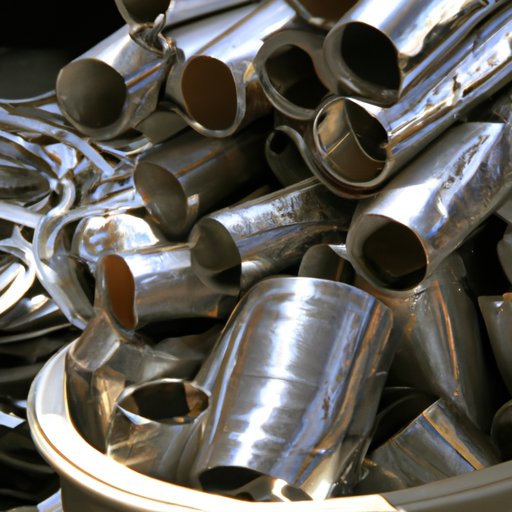Introduction
Stainless steel is an alloy composed of several metals, mainly iron, chromium, and nickel. It is a durable and versatile material used in a variety of applications, such as construction, automotive, medical, and more. In this article, we will explore how stainless steel works, from its composition and physical/chemical properties to its manufacturing process and corrosion-resistant nature. We will also look into the benefits of using stainless steel in everyday life, as well as the advantages of recycling it.
Exploring the Properties of Stainless Steel and How It Works
Stainless steel is a metal alloy that is composed of several elements, including iron, chromium, nickel, and other metals, depending on the grade of stainless steel. Iron is the primary component, making up about two-thirds of the alloy. Chromium is the most important element in creating stainless steel because it provides corrosion resistance. Nickel is added to increase strength, while other elements, such as manganese and molybdenum, are added to enhance corrosion resistance.
The physical properties of stainless steel vary depending on the grade, but all grades have excellent strength, ductility, and toughness. It is also highly resistant to heat, making it suitable for high-temperature applications. The chemical properties of stainless steel make it resistant to corrosion, oxidation, and abrasion, as well as highly durable and long-lasting.

A Look into the Manufacturing Process of Stainless Steel
The manufacturing process of stainless steel involves melting down the different raw materials and combining them together. This is done in an electric arc furnace or a basic oxygen furnace. Once the desired composition is achieved, the molten metal is poured into ingots, which are then rolled and forged into various shapes. There are several alloys used to create different types of stainless steel, each with its own set of properties.
The manufacturing process can also involve additional steps such as heat treatment, pickling, and passivation. Heat treatment is used to change the structure of the metal and improve its properties, while pickling and passivation are used to remove impurities and protect the surface of the metal. These processes help ensure that the stainless steel is of the highest quality and has the desired properties.
Understanding the Corrosion-Resistant Nature of Stainless Steel
The corrosion-resistant nature of stainless steel is due to the presence of chromium. When exposed to oxygen, chromium forms a thin layer of chromium oxide on the surface of the steel. This layer acts as a barrier between the metal and the environment, preventing the steel from corroding. Other elements, such as molybdenum, nickel, and nitrogen, also contribute to the corrosion-resistant nature of stainless steel.
Examining the Role of Chromium in Making Stainless Steel
Chromium is essential for creating stainless steel because it provides corrosion resistance. The more chromium present, the greater the corrosion resistance. Different grades of stainless steel are created based on the amount of chromium present. For example, 304 stainless steel contains 18% chromium and 8% nickel, while 316 stainless steel contains 16% chromium, 10% nickel, and 2% molybdenum.

The Benefits of Using Stainless Steel in Everyday Life
Stainless steel is a popular choice for many everyday items because of its durability and ease of maintenance. It is highly resistant to heat, corrosion, and abrasion, making it suitable for a variety of uses. Its versatility allows it to be used for everything from kitchen appliances and cookware to bridges and skyscrapers. In addition, it is non-toxic, recyclable, and easy to clean.

Investigating the Advantages of Recycling Stainless Steel
Recycling stainless steel is beneficial in many ways. One of the biggest advantages is that it reduces the environmental impact of producing new stainless steel. By recycling, less energy is used and fewer resources are wasted. In addition, recycling helps save money by reducing the cost of production. Finally, recycled stainless steel is readily available and can often be found at a lower price than new stainless steel.
Conclusion
Stainless steel is a versatile and durable material used in a variety of applications. Its unique composition and physical/chemical properties make it resistant to corrosion, oxidation, and abrasion. The manufacturing process involves melting down the raw materials and combining them together, as well as additional steps such as heat treatment, pickling, and passivation. The corrosion-resistant nature of stainless steel is due to the presence of chromium. Finally, the benefits of using stainless steel in everyday life, as well as the advantages of recycling it, make it a popular choice for many products.
(Note: Is this article not meeting your expectations? Do you have knowledge or insights to share? Unlock new opportunities and expand your reach by joining our authors team. Click Registration to join us and share your expertise with our readers.)
